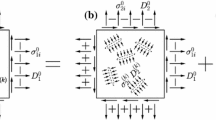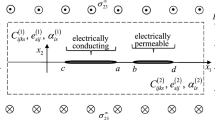Abstract
The influence of electrostatic tractions acting upon crack faces on the fracture mechanical quantities in piezoelectric materials under electromechanical loading is investigated. The physical background are the mechanical and dielectric equilibria at an interface between two dielectric domains and related mechanical stresses. The model is applied to a crack problem, where a dielectric interface exists between the solid material and the insulating crack medium. The analytical solution for a crack in an infinite piezoelectric body accounting for intrinsic charges and electrostatic stresses on the crack faces gives insight into the influence of crack boundary conditions on the field intensity factors. Varying loading conditions and the dielectric permittivity of the flaw yields a parameter range in which induced crack surface tractions are relevant. Then, the calculation of the J-integral for thermodynamically consistent crack boundary conditions is discussed. The line integral along the crack faces is replaced by a simple jump term. This approach comes out to be exact only for a simplified model of the electrostatic tractions.
Similar content being viewed by others
References
Barenblatt GI (1962) The mathematical theory of equilibrium cracks in brittle fracture. Academic Press (Adv Appl Mech) 7: 55–129
Cherepanov G (1967) Rasprostranenie trechin v sploshnoi srede (About crack advance in the continuum). Prikladnaja Matematika i Mekhanica 31: 478–488
Dugdale D (1960) Yielding of steel sheets containing slits. J Mech Phys Solids 8: 100–104
Eshelby JD (1951) The force on an elastic singularity. Phil Trans R Soc Lond A 244: 87–112
Eshelby JD (1975) The elastic energy-momentum tensor. J Elast 5: 321–335
Hao TH, Shen ZY (1994) A new electric boundary condition of electric fracture mechanics and its applications. Eng Fract Mech 47: 793–802
Kemmer G, Balke H (1999) Kraftwirkung auf die Flanken nichtleitender Risse in Piezoelektrika. In: GAMM 98 (short communications in mathematics and mechanics, ZAMM), 79, pp 509–510
Landis CM (2004) Energetically consistent boundary conditions for electromechanical fracture. Int J Solids Struct 41: 6291–6315
Landis CM, McMeeking RM (2000) Modeling of fracture in ferroelectric ceramics. In: Proceedings of SPIE, 3992, pp 176–184
Lenk A (1974) Elektromechanische Systeme, Band 2 (Systeme mit verteilten Parametern). VEB Verlag Technik, Berlin
Maugin GA, Epstein M (1991) The electroelastic energy-momentum tensor. Proc R Soc Lond A 433: 299–312
McMeeking RM (1989) Electrostrictive stresses near crack-like flaws. J Appl Math Phys (ZAMP) 40: 615–627
McMeeking RM (1999) Crack tip energy release rate for a piezoelectric compact tension specimen. Eng Fract Mech 64: 217–244
McMeeking RM (2004) The energy release rate for a Griffith crack in a piezoelectric material. Eng Fract Mech 71: 1169–1183
Pak YE (1990) Crack extension force in a piezoelectric material. J Appl Mech 57: 647–653
Pak YE (1992) Linear electro-elastic fracture mechanics of piezoelectric materials. Int J Fract 54: 79–100
Pak YE, Herrmann G (1986) Conservation laws and the material momentum tensor for the elastic dielectric. Int J Eng Sci 24: 1365–1374
Parton VZ (1976) Fracture mechanics of piezoelectric materials. Acta Astronaut 3: 671–683
Rice JR (1968) A path independent integral and the approximate analysis of strain concentration by notches and cracks. J Appl Mech 35: 379–386
Ricoeur A, Kuna M (2003) Influence of electric fields on the fracture of ferroelectric ceramics. J Eur Ceram Soc 23: 1313–1328
Ricoeur A, Kuna M, (2008) Electrostatic tractions at dielectric interfaces and their implication for crack boundary conditions. Mech Res Commun. doi:10.1016/j.mechrescom.2008.09.009
Ricoeur A, Enderlein M, Kuna M (2005) Calculation of the J-integral for limited permeable cracks in piezoelectrics. Arch Appl Mech 74: 536–549
Schneider GA, Felten F, McMeeking RM (2003) The electrical potential difference across cracks in PZT measured by Kelvin Probe Microscopy and the implications for fracture. Acta Mater 51: 2235–2241
Westram I, Ricoeur A, Emrich A, Rödel J, Kuna M (2007) Fatigue crack growth law for ferroelectrics under cyclic electrical and combined electromechanical loading. J Eur Ceram Soc 27: 2485–2494
Wippler K, Ricoeur A, Kuna M (2004) Towards the computation of electrically permeable cracks in piezoelectrics. Eng Fract Mech 71: 2567–2587
Author information
Authors and Affiliations
Corresponding author
Rights and permissions
About this article
Cite this article
Ricoeur, A., Kuna, M. Electrostatic tractions at crack faces and their influence on the fracture mechanics of piezoelectrics. Int J Fract 157, 3–12 (2009). https://doi.org/10.1007/s10704-009-9321-z
Received:
Accepted:
Published:
Issue Date:
DOI: https://doi.org/10.1007/s10704-009-9321-z




